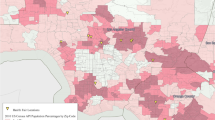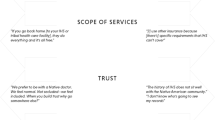Abstract
The purpose of this project was to design, implement, and assess a recurring interdisciplinary community health fair in an underserved border town. University of California San Diego (UCSD) medical and pharmacy students, under faculty supervision, worked alongside community partners in Calexico, California to implement a health fair two miles from the U.S.–Mexico border. Demographic and screening data were described from 293 participants from 2014 to 2016. Over 90% (269/293) listed Mexico as their country of birth, 82.9% (243/293) were monolingual Spanish speakers, 75.4% (221/293) had an annual household income of ≤ $20,000, and 58.7% (172/293) described their health as fair or poor. Screening revealed 91.1% (265/291) were overweight or obese, 37.8% (109/288) had hypertension, 9.3% (27/289) had elevated blood sugar, and 11.4% (33/289) had elevated total cholesterol levels. This model could be replicated in other training settings to increase exposure to border health issues and connect patients to local health services.
Similar content being viewed by others

References
Murray K, Liang A, Barnack-Tavlaris J, Navarro AM. The reach and rationale for community health fairs. J Cancer Educ. 2014;29(1):19–24.
Ezeonwu M, Berkowitz B. A collaborative communitywide health fair: the process and impacts on the community. J Community Health Nurs. 2014;31(2):118 – 29.
Dulin MK, Olive KE, Florence JA, Sliger C. The financial value of services provided by a rural community health fair. J Health Care Poor Underserved. 2006;17(4):821–9.
Briant KJ, Wang L, Holte S, Ramos A, Marchello N, Thompson B. Understanding the impact of colorectal cancer education: a randomized trial of health fairs. BMC Public Health. 2015;15:1196.
Adekeye OA, Adesuyi BF, Takon JG. Barriers to healthcare among African immigrants in Georgia, USA. J Immigr Minor Health. 2017. https://doi.org/10.1007/s10903-017-0549-9.
Landy DC, Gorin MA, O’Connell MT. Student-led rural health fairs: attempting to improve medical education and access to health care. South Med J. 2011;104(8):598–603.
Landy DC, Gorin MA, Egusquiza JD, Weiss J, O’Connell MT. Medical student attitudes before and after participation in rural health fairs. J Res Med Sci. 2012;17(3):298–303.
Calexico—your strategic border site. City of Calexico, California. City of Calexico. http://www.calexico.ca.gov. Accessed 14 Sept 2017.
United States Census Bureau. Quick facts. Calexico City, California. https://www.census.gov/quickfacts/fact/table/calexicocitycalifornia,CA/EDU685215#viewtop. Accessed14 Sept 2017.
United States Census Bureau. Community facts. 2011–2015 American community survey 5-year estimates. Calexico City, California. https://www.census.gov/quickfacts/table/EDU635215/0609710,06. Accessed 14 Sept 2017.
Betancourt JR, Green AR, Carrillo JE. Cultural competence in health care: emerging frameworks and practical approaches. New York: Commonwealth Fund; 2002.
Escarce JJ, Kapur K. Access to and quality of health care. In: Tienda M, Mitchell F, editors. Hispanics and the future of America. National Research Council (US) Panel on Hispanics in the United States. Washington (DC): National Academies Press (US); 2006.
Laurel L, Jacobs K, Dietz M, Graham-Squire D, Pourat N, Roby DH. After millions of Californians gain health coverage under the affordable care act, who will remain uninsured? California: UCLA Center for Health Policy Research; 2012.
Centers for Disease Control and Prevention. Healthy weight. About adult BMI. https://www.cdc.gov/healthyweight/assessing/bmi/adult_bmi/index.html. Accessed 14 Sept 2017.
Chobanian AV, et al. The seventh report of the joint national committee on prevention, detection, evaluation, and treatment of high blood pressure: the JNC 7 report. JAMA. 2003;289:2560–72.
Third Report of the National Cholesterol Education Program (NCEP), Expert Panel on Detection, Evaluation, and Treatment of High Blood Cholesterol in Adults (Adult Treatment Panel III). Third report of the national cholesterol education program (NCEP) expert panel on detection, evaluation, and treatment of high blood cholesterol in adults (adult treatment panel III) final report. Circulation. 2002;106:3143–421.
Cefalu WT. American diabetes association standards of medical care in diabetes—2017. Diabetes Care. 2017;40(Supplement 1):S1–135.
Mossey JM, Shapiro E. Self-rated health: a predictor of mortality among the elderly. Am J Public Health. 1982;72:800–8.
Burstrom B, Fredlund P. Self rated health: is it as good a predictor of subsequent mortality among adults in lower as well as in higher social classes? J Epidemiol Community Health. 2001;55(11):836 – 40.
Health Impact Assessment. The determinants of health. World Health Organization. http://www.who.int/hia/evidence/doh/en/. Accessed 14 Sept 2017.
Poirier P, Giles TD, Bray GA, Hong Y, Stern JS, Pi-Sunyer FX, Eckel RH. American Heart Association; Obesity Committee of the Council on Nutrition, Physical Activity, and Metabolism. Obesity and cardiovascular disease: pathophysiology, evaluation, and effect of weight loss: an update of the 1997 American heart association scientific statement on obesity and heart disease from the obesity committee of the council on nutrition, physical activity, and metabolism. Circulation. 2006;113(6):898–918.
Cullen KW, Baranowski T, Smith SP. Using goal setting as a strategy for dietary behavior change. J Am Diet Assoc. 2001;101(5):562–6.
Shilts MK, Horowitz M, Townsend MS. Goal setting as a strategy for dietary and physical activity behavior change: a review of the literature. Am J Health Promot. 2004;19(2):81–93.
Brach C, Fraserirector I. Can cultural competency reduce racial and ethnic health disparities? A review and conceptual model. Med Care Res Rev. 2000;57(Suppl 1):181–217.
Patterson DG, Carline JD. Promoting minority access to health careers through health profession-public school partnerships: a review of the literature. Acad Med. 2006;81(6 Suppl):S5–10.
Ohlson B. The connecting the dots initiative—a comprehensive approach to increase health professions workforce diversity in California: increasing the diversity of the health professions K-12 networks of support. The Public Health Institute and UC Berkeley School of Public Health; 2008.
Profiles in leadership: a review of exemplary practices to increase health professions workforce diversity in California. The Public Health Institute and UC Berkeley School of Public Health; 2008.
Acknowledgements
This research was supported by the University of California School of Medicine and the Physician Assessment and Clinical Education (PACE) grant. We thank Santo Tomas Swap Meet for the support and generosity in hosting our health fairs year after year. We thank our colleagues Marcela Zhou, Eduardo Fricovsky Pharm D., and Clara Padron-Spence MD who provided their service in the successful implementation of this project. We also thank all medical, pharmacy, and high school volunteers, as well as all the community organizations that have partnered with us in offering their resources and time.
Author information
Authors and Affiliations
Corresponding author
Ethics declarations
Informed Consent
This study was reviewed and approved as exempt by the UCSD Institutional Review Board.
Rights and permissions
About this article
Cite this article
Lee, J., McKennett, M., Rodriguez, X. et al. Implementation and Evaluation of a Recurring Interdisciplinary Community Health Fair in a Remote U.S.–Mexico Border Community. J Immigrant Minority Health 21, 136–142 (2019). https://doi.org/10.1007/s10903-018-0718-5
Published:
Issue Date:
DOI: https://doi.org/10.1007/s10903-018-0718-5



